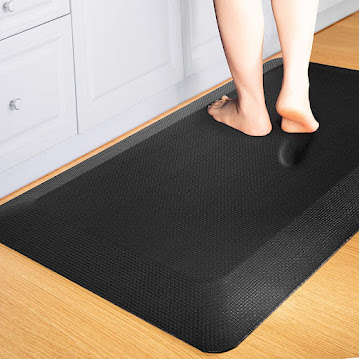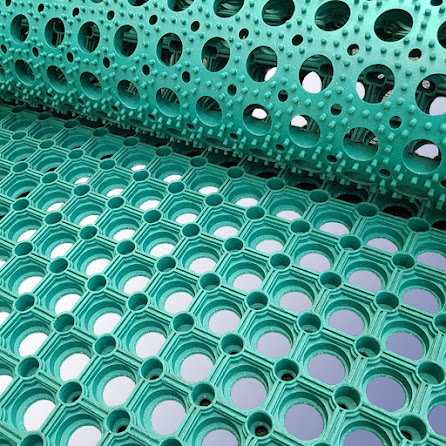Benefits of Anti-Fatigue Mats
Our anti-fatigue mats help ease leg, foot, and lower back fatigue and pain. Some other benefits of using anti-fatigue mats include a 50 percent reduction in tiredness and discomfort and reducing absenteeism by a third. Anti Fatigue Mats help decrease foot and lower limb disorders for workers who stand for long periods. Discomfort, tiredness, and sore feet, legs, knees, or hips after long hours of standing can impact an employee's productivity and cause health issues later. Research has shown standing for long periods of time is particularly stressful and fatiguing. Anti-fatigue mats help absorb the shock due to walking and standing. This cushioning effect reduces foot fatigue and leg stress over long periods.
What are anti-fatigue mats?
Anti-fatigue mats are mats designed to reduce fatigue caused by standing for long periods on a hard surface (e.g., cement floors). Fatigue-reducing mats can be made of various materials including rubber, carpeting materials, vinyl, and wood.
Why use anti-fatigue mats?
Anti-fatigue mats are often used to decrease foot and lower limb disorders for workers who stand in one position for long periods. However, providing a mat may not solve the entire problem. According to scientific data, standing for long periods of time is particularly stressful and fatiguing. Regardless of the quality of shoes and quality of the floor covering, standing itself can cause tiredness after an entire working day.
What should be considered first when a person stands all day at work?
When considering the use of Anti Fatigue Rubber Mats, there are other factors that should be considered at the same time, such as allowing changes in working/standing position, footwear, and flooring. Changes in working/standing position: Work should be organized so that the worker has some choice about his/her working position and an opportunity to change position frequently. A workplace that includes an optional seat (chair, sit/stand stool) and some kind of footrest increases the variety of body positions and encourages frequent changes between them.
Footwear: Footwear is a factor which, if properly chosen, may further reduce the harmful effects of prolonged standing. There is no doubt that the choice of footwear is an important consideration for people who work on their feet. Shoes should ensure adequate arch and heel support and cushioning while providing comfort to the wearer.
Flooring: The type of flooring used in the workplace has an equally important influence on comfort, especially on tender feet. Hard, unyielding floors, like concrete, are the least comfortable surface to work on. Walking on a hard floor is similar to the impact of a hammer pounding the heel at every step. Wood, cork, carpeting, or rubber - anything that provides some elasticity - is generally gentler on workers' feet.
When should anti-fatigue mats be used?
There are two options to alleviate foot discomfort where resilient floors are not practical. One is footwear with thick insulating soles and shock-absorbing insoles. Anti Fatigue Matting is the other option. Anti-fatigue mats absorb the shock due to walking and this cushioning effect reduces foot fatigue. However, the use of matting requires caution because mats can lead to tripping and falling accidents when installed improperly.




Comments
Post a Comment